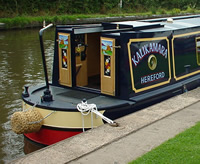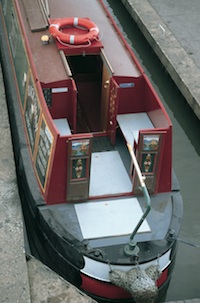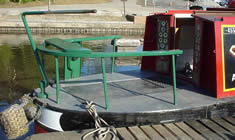Canal Boat Types
A UK Canal Boating Article
Category : General
Cruiser Stern
Cruiser stern narrowboats are designed to allow more people to be on deck during the reasonably good weather of the British summer holiday season.
The hatch and rear doors are farther forward than on a traditional boat, creating a large open deck between counter and rear doors, protected by a rail (perhaps with seats) around the back and sides.
At the rear, a "cruiser" narrowboat looks very different from traditional boats. The large rear deck provides a good social space or al fresco dining area, but in the winter (or the occasionally less than perfect weather of the British Summer) the steerer is quite unprotected from wind and rain.
The lack of an enclosed engine room means that engine heat does not contribute to keeping the boat warm and there is wasted space above the deck area. The name for this style arises because the large open rear deck resembles that of the large rear cockpits common on glass fibre river cruisers.
The "cruiser" stern also allows the engine to be located under the deck and not in the cabin as it is in a traditional-stern boat.
Semi Traditional Stern
A semi-traditional stern is a compromise to gain some of the "social" benefits of a cruiser stern, while retaining a more traditional design and providing some protection for the steerer in bad weather or in cooler seasons.
As with the cruiser stern, the deck is extended back from the hatch and rear doors, but in this case most of the deck is protected at the sides by walls which extend back from the cabin sides – giving a more sheltered area for the steerer and companions, usually with lockers to sit on.
The engine is located under the deck, much like a cruiser, again allowing a separation between the cabin and the engine bay, with the steps down to the cabin being located past the false sides of the "semi-trad" social area.
Traditional Stern
Many modern canal boats retain the traditional layout of a small open, unguarded "counter" or deck behind the rear doors from which the crew can step onto land. It is possible to steer from the counter, but this is not very safe, with the propeller churning below only one misstep away.
The length of the "tiller extension" allows the steerer to stand more safely on the top step, forward of the rear doors (on a working boat, this step would have been over the top of the coal box).
On cold days, the steerer can even close the rear doors behind him, and be in relative comfort, his lower body in the warmth of the cabin, and only his upper body emerging from the hatchway and exposed to the elements.
In good weather, many trad-stern steerers sit up on the hatchway edge, a high vantage point giving good all-round visibility.
On trad boats, the bow "well-deck" forms the main outside viewing area, because the traditional stern is not large enough for anyone other than the steerer to stand on safely.
Cruiser stern narrowboats are designed to allow more people to be on deck during the reasonably good weather of the British summer holiday season.
The hatch and rear doors are farther forward than on a traditional boat, creating a large open deck between counter and rear doors, protected by a rail (perhaps with seats) around the back and sides.
At the rear, a "cruiser" narrowboat looks very different from traditional boats. The large rear deck provides a good social space or al fresco dining area, but in the winter (or the occasionally less than perfect weather of the British Summer) the steerer is quite unprotected from wind and rain.
The lack of an enclosed engine room means that engine heat does not contribute to keeping the boat warm and there is wasted space above the deck area. The name for this style arises because the large open rear deck resembles that of the large rear cockpits common on glass fibre river cruisers.
The "cruiser" stern also allows the engine to be located under the deck and not in the cabin as it is in a traditional-stern boat.
Semi Traditional Stern
A semi-traditional stern is a compromise to gain some of the "social" benefits of a cruiser stern, while retaining a more traditional design and providing some protection for the steerer in bad weather or in cooler seasons.
As with the cruiser stern, the deck is extended back from the hatch and rear doors, but in this case most of the deck is protected at the sides by walls which extend back from the cabin sides – giving a more sheltered area for the steerer and companions, usually with lockers to sit on.
The engine is located under the deck, much like a cruiser, again allowing a separation between the cabin and the engine bay, with the steps down to the cabin being located past the false sides of the "semi-trad" social area.
Traditional Stern
Many modern canal boats retain the traditional layout of a small open, unguarded "counter" or deck behind the rear doors from which the crew can step onto land. It is possible to steer from the counter, but this is not very safe, with the propeller churning below only one misstep away.
The length of the "tiller extension" allows the steerer to stand more safely on the top step, forward of the rear doors (on a working boat, this step would have been over the top of the coal box).
On cold days, the steerer can even close the rear doors behind him, and be in relative comfort, his lower body in the warmth of the cabin, and only his upper body emerging from the hatchway and exposed to the elements.
In good weather, many trad-stern steerers sit up on the hatchway edge, a high vantage point giving good all-round visibility.
On trad boats, the bow "well-deck" forms the main outside viewing area, because the traditional stern is not large enough for anyone other than the steerer to stand on safely.
Holiday Bases
n/a
Canals
n/a
Rivers
n/a



Places to Visit
n/a
